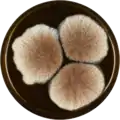| Aspergillus lacticoffeatus | |
|---|---|
| Scientific classification | |
| Domain: | Eukaryota |
| Kingdom: | Fungi |
| Division: | Ascomycota |
| Class: | Eurotiomycetes |
| Order: | Eurotiales |
| Family: | Aspergillaceae |
| Genus: | Aspergillus |
| Species: | A. lacticoffeatus |
| Binomial name | |
| Aspergillus lacticoffeatus Frisvad & Samson (2004)[1] | |
Aspergillus lacticoffeatus is a species of fungus in the genus Aspergillus. It belongs to the group of black Aspergilli which are important industrial workhorses.[2][3][4] A. lacticoffeatus belongs to the Nigri section. It was first described in 2004.[1] It has been found on coffee beans in Venezuela and Indonesia, and is an effective producer of ochratoxin.[1] It has an unfunctional PKS gene (pksA) for the production of black conidium pigment, which makes it the only species in the Nigri section which is brown and not black. It has been proposed that this species might not be a separate species but instead a mutated A. niger.[5]
The genome of A. lacticoffeatus was sequenced in 2014 as part of the Aspergillus whole-genome sequencing project – a project dedicated to performing whole-genome sequencing of all members of the genus Aspergillus.[6] Its genome assembly size was 35.86 Mbp.[6]
Growth and morphology
Aspergillus lacticoffeatus has been cultivated on both Czapek yeast extract agar (CYA) plates and Malt Extract Agar Oxoid (MEAOX) plates. The growth morphology of the colonies can be seen in the pictures below.
 Aspergillus lacticoffeatus growing on CYA plate
Aspergillus lacticoffeatus growing on CYA plate Aspergillus lacticoffeatus growing on MEAOX plate
Aspergillus lacticoffeatus growing on MEAOX plate
References
- 1 2 3 Samson, R. A. New ochratoxin A or sclerotium producing species in Aspergillus section Nigri. Studies in Mycology 2004, 50, 45–61.
- ↑ Pel, H. J.; de Winde, J. H.; Archer, D. B.; Dyer, P. S.; Hofmann, G.; Schaap, P. J.; Turner, G.; de Vries, R. P.; Albang, R.; Albermann, K.; Andersen, M. R.; Bendtsen, J. D.; Benen, J. A. E.; van den Berg, M.; Breestraat, S.; Caddick, M. X.; Contreras, R.; Cornell, M.; Coutinho, P. M.; Danchin, E. G. J.; Debets, A. J. M.; Dekker, P.; van Dijck, P. W. M.; van Dijk, A.; Dijkhuizen, L.; Driessen, A. J. M.; d’Enfert, C.; Geysens, S.; Goosen, C.; Groot, G. S. P.; de Groot, P. W. J.; Guillemette, T.; Henrissat, B.; Herweijer, M.; van den Hombergh, J. P. T. W.; van den Hondel, C. A. M. J. J.; van der Heijden, R. T. J. M.; van der Kaaij, R. M.; Klis, F. M.; Kools, H. J.; Kubicek, C. P.; van Kuyk, P. A.; Lauber, J.; Lu, X.; van der Maarel, M. J. E. C.; Meulenberg, R.; Menke, H.; Mortimer, M. A.; Nielsen, J.; Oliver, S. G.; Olsthoorn, M.; Pal, K.; van Peij, N. N. M. E.; Ram, A. F. J.; Rinas, U.; Roubos, J. A.; Sagt, C. M. J.; Schmoll, M.; Sun, J.; Ussery, D.; Varga, J.; Vervecken, W.; van de Vondervoort, P. J. J.; Wedler, H.; Wösten, H. A. B.; Zeng, A.-P.; van Ooyen, A. J. J.; Visser, J.; Stam, H. Genome sequencing and analysis of the versatile cell factory Aspergillus niger CBS 513.88. Nat. Biotechnol. 2007, 25, 221–231, doi:10.1038/nbt1282.
- ↑ Goldberg, I.; Rokem, J. S.; Pines, O. Organic acids: old metabolites, new themes. Journal of Chemical Technology & Biotechnology 2006, 81, 1601–1611, doi:10.1002/jctb.1590.
- ↑ Pariza, M. W.; Foster, E. M. Determining the Safety of Enzymes Used in Food Processing. Journal of Food Protection 1983, 46, 453–468, doi:10.4315/0362-028X-46.5.453.
- ↑ Jørgensen, T. R.; Park, J.; Arentshorst, M.; van Welzen, A. M.; Lamers, G.; Vankuyk, P. A.; Damveld, R. A.; van den Hondel, C. A. M.; Nielsen, K. F.; Frisvad, J. C.; Ram, A. F. J. The molecular and genetic basis of conidial pigmentation in Aspergillus niger. Fungal Genet. Biol. 2011, 48, 544–553, doi:10.1016/j.fgb.2011.01.005.
- 1 2 "Home - Aspergillus niger (lacticoffeatus) CBS 101883 v1.0". Genome.jgi.doe.gov. Retrieved 2 May 2022.